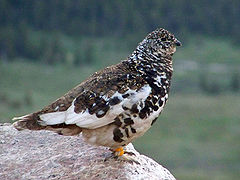Lagopus
| Lagopus[1] | |
| Brisson, 1760[2] | |
 Przedstawiciel rodzaju – pardwa białosterna (L. leucurus) | |
| Systematyka | |
| Domena | eukarionty |
|---|---|
| Królestwo | zwierzęta |
| Typ | strunowce |
| Podtyp | kręgowce |
| Gromada | ptaki |
| Podgromada | Neornithes |
| Infragromada | ptaki neognatyczne |
| Rząd | grzebiące |
| Rodzina | kurowate |
| Podrodzina | bażanty |
| Plemię | Tetraonini |
| Rodzaj | Lagopus |
| Typ nomenklatoryczny | |
Tetrao lagopus Linnaeus, 1758 | |
| Synonimy | |
| Gatunki | |
| |
Lagopus – rodzaj ptaka z podrodziny bażantów (Phasianinae) w rodzinie kurowatych (Phasianidae).
Zasięg występowania
Rodzaj obejmuje gatunki występujące w Ameryce Północnej i Eurazji[7].
Morfologia
Długość ciała 31–43 cm; masa ciała samców 326–900 g, samic 358–750 g[8].
Systematyka
Etymologia
- Lagopus: łac. lagopus, lagopodis „pardwa”, od gr. λαγωπους lagōpous, λαγωποδος lagōpodos „pardwa, szorstko-stopy jak zając”, od λαγως lagōs „zając”; πους pous, ποδος podos „stopa”[9].
- Attagen: łac. attagen, attagenis „ptak łowny”, od gr. ατταγην attagēn, ατταγηνος attagēnos „frankolin” (por. średniowiecznołac. attagines „pardwa”). Ptak ten był wymieniany przez wielu autorów klasycznych i pomimo licznych wcześniejszych identyfikacji, panuje ogólna zgoda, że jest to frankolin obrożny[10]. Gatunek typowy: Tetrao mutus Montin, 1776.
- Oreias: gr. ορειας oreias, ορειαδος oreiados „z gór, górska nimfa, Oready”, od ορος oros, ορεος oreos „góra”[11]. Gatunek typowy: Tetrao scoticus Latham, 1787[a].
- Acetinornis: gr. ακητον akēton „najlepszy, najdoskonalszy”; ορνις ornis, ορνιθος ornithos „ptak” (por. gr. ακεντρος akentros „bez ostrogi”)[12]. Gatunek typowy: Tetrao scoticus Latham, 1787.
- Keron: lap. nazwa Keron dla pardwy górskiej[13]. Gatunek typowy: Tetrao mutus Montin, 1776.
Podział systematyczny
Do rodzaju należą następujące gatunki[14]:
- Lagopus lagopus – pardwa mszarna
- Lagopus muta – pardwa górska
- Lagopus leucura – pardwa białosterna
Uwagi
- ↑ Podgatunek L. lagopus
Przypisy
- ↑ Lagopus, [w:] Integrated Taxonomic Information System [online] (ang.).
- ↑ M.J. Brisson: Ornithologie, ou, Méthode contenant la division des oiseaux en ordres, sections, genres, especes & leurs variétés: a laquelle on a joint une description exacte de chaque espece, avec les citations des auteurs qui en ont traité, les noms quils leur ont donnés, ceux que leur ont donnés les différentes nations, & les noms vulgaires. T. 1. Parisiis: Ad Ripam Augustinorum, apud Cl. Joannem-Baptistam Bauche, bibliopolam, ad Insigne S. Genovesae, & S. Joannis in Deserto, 1760, s. 26, 181. (łac. • fr.)
- ↑ Kaup 1829 ↓, s. 170.
- ↑ Kaup 1829 ↓, s. 177.
- ↑ C.L. Bonaparte. Tableaux paralléliques de l’ordre des Gallinacés. „Comptes rendus hebdomadaires des séances de l’Académie des sciences”. 42, s. 880, 1856 (fr.).
- ↑ J.E. Gray: Hand-list of genera and species of birds: distinguishing those contained in the British Museum. Cz. 2. London: printed by order of the Trustees, 1870, s. 278. (ang.)
- ↑ F. Gill & D. Donsker: Pheasants, partridges & francolins (ang.). IOC World Bird List: Version 8.2. [dostęp 2018-09-13].
- ↑ E. de Juana: Family Tetraonidae (Grouse). W: J. del Hoyo, A. Elliott & J. Sargatal: Handbook of the Birds of the World. Cz. 2: New World Vultures to Guineafowl. Barcelona: Lynx Edicions, 1994, s. 402–403. ISBN 84-87334-15-6. (ang.)
- ↑ The Key to Scientific Names ↓, Lagopus [dostęp 2018-09-13].
- ↑ The Key to Scientific Names ↓, Attagen [dostęp 2018-09-13].
- ↑ The Key to Scientific Names ↓, Oreias [dostęp 2018-09-13].
- ↑ The Key to Scientific Names ↓, Acetinornis [dostęp 2018-09-13].
- ↑ The Key to Scientific Names ↓, Keron [dostęp 2018-09-13].
- ↑ Systematyka i nazwy polskie za: P. Mielczarek & M. Kuziemko: Plemię: Tetraonini Leach, 1820 (wersja: 2017-05-11). W: Kompletna lista ptaków świata [on-line]. Instytut Nauk o Środowisku Uniwersytetu Jagiellońskiego. [dostęp 2018-09-13].
Bibliografia
- The Key to Scientific Names, J.A. Jobling (red.), [w:] Birds of the World [online], S.M. Billerman et al. (red.), Cornell Lab of Ornithology, Ithaca (ang.).
- J.J. Kaup: Skizzirte Entwickelungs-Geschichte und natürliches System der europäischen Thierwelt: Erster Theil welcher die Vogelsäugethiere und Vögel nebst Andeutung der Entstehung der letzteren aus Amphibien enthält. Darmstadt: In commission bei Carl Wilhelm Leske, 1829, s. 1–203. (niem.)
Media użyte na tej stronie
Autor: (of code) -xfi-, Licencja: CC BY-SA 3.0
The Wikispecies logo created by Zephram Stark based on a concept design by Jeremykemp.
Autor: Footwarrior, Licencja: CC BY-SA 3.0
White-tailed Ptarmigan, Lagopus Leucura. Mt. Evans, Colorado.

